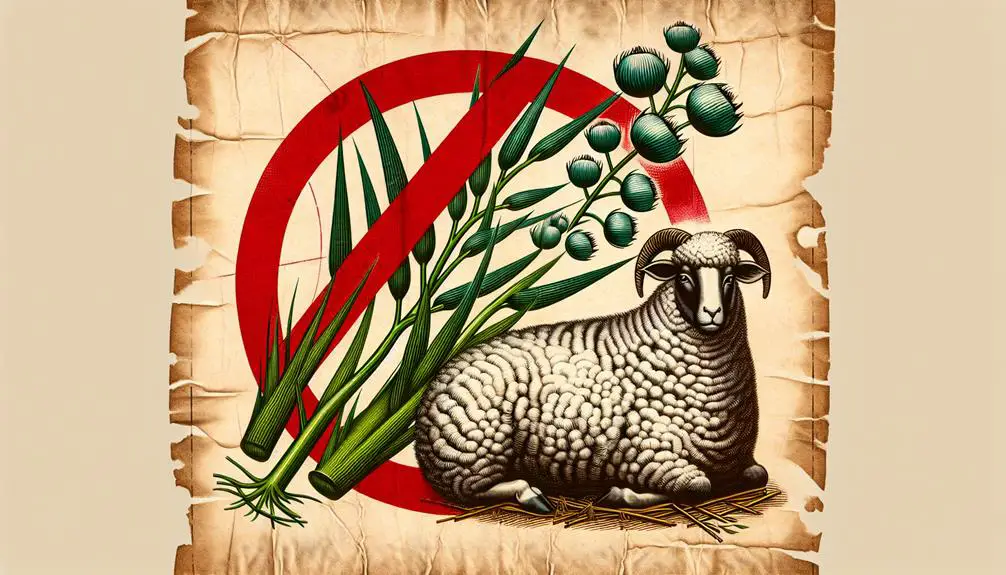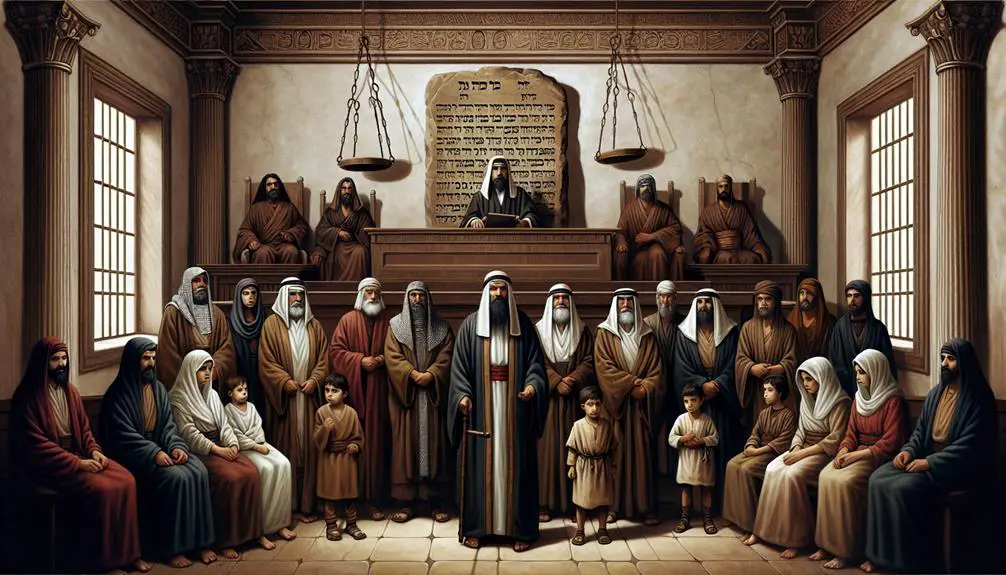Strange biblical laws revealed: from fabric mixes to eating habits, discover the unexpected rules that guided ancient lives.

Crazy Laws in the Bible
As they say, the devil is in the details, and you might find yourself surprised by some of the more peculiar laws tucked away in the Bible. From prohibitions against wearing mixed fabrics to rules about not eating seafood that lacks fins and scales, these ancient directives can seem bewildering through a modern lens.
You're likely curious about the rationale behind such specific regulations, and how they served the communities they were intended for. Stick around, and let's explore together the historical and cultural contexts that birthed these seemingly odd laws, shedding light on a past world that's both alien and familiar.
Key Takeaways
- The Bible contains unique laws, such as prohibitions against mixing fabrics, reflecting deep cultural and religious values.
- Specific animal regulations, like deeming the bald eagle unclean, highlight early conservation efforts and respect for nature.
- Beard regulations in the Bible carry historical and religious significance, symbolizing social hierarchy, identity, and piety.
- Modern interpretations of these ancient laws vary, raising questions about their ethical implications and relevance today.
Mixed Fabrics Forbidden

One intriguing mandate found in the Bible prohibits the mixing of different types of fabrics, a rule that reflects the complex interplay of cultural, religious, and symbolic values of the time. This prohibition, nestled within ancient texts, invites you to ponder the implications for both past and present societies, especially in the context of fabric trends and environmental impacts.
In examining this mandate, you discover a nuanced approach to the materials that clothe humanity, suggesting a harmony with the natural world that modern fabric trends often overlook.
Today's fabric industry, marked by fast fashion and a relentless pursuit of new trends, stands in stark contrast to this ancient wisdom. The environmental impacts of modern textile production, from water pollution to carbon emissions, underscore a departure from the sustainable practices implied by the biblical injunction.
As you delve deeper, you'll find that this ancient rule encourages a reconsideration of our current practices, pointing towards a more sustainable and thoughtful approach to fashion. This exploration reveals not just a curious decree from the past but a timeless lesson on the importance of environmental stewardship and the mindful use of resources.
The Bald Eagle Ban

While exploring ancient mandates on fabric reveals a call for environmental stewardship, the Bible's stance on the bald eagle invites us to consider the symbolic significance of animals in religious texts. You'll find that the Bible categorizes the bald eagle among unclean animals, not to be consumed. This directive, while seemingly peculiar, echoes a broader theme throughout the text, where animals hold profound symbolic roles.
Eagle symbolism, deeply entrenched in various cultures, often represents strength, freedom, and divine connection. In the Biblical context, the eagle's inclusion in dietary laws isn't a mere prohibition but a gesture towards respecting an animal imbued with spiritual significance. This respect aligns with modern conservation efforts, where the bald eagle, once endangered, has become a success story due to dedicated protection measures.
Your understanding of these ancient texts enriches when you consider them not as arbitrary rules but as early attempts at conservation and a means to instill reverence for nature's entities. This perspective bridges the gap between ancient mandates and contemporary conservation efforts, highlighting the timeless relevance of these teachings in fostering an ethic of respect and protection for the natural world.
Beard Trimming Regulations

You might find the biblical regulations on beard trimming peculiar, yet they're steeped in historical significance. Understanding their context reveals much about the social and religious practices of the time, while interpretations of these rules vary widely in modern times.
The cultural significance today invites a nuanced discussion on how ancient laws influence contemporary beliefs and practices.
Historical Context Explained
Delving into the historical context, the biblical prohibition against certain forms of beard trimming reflects deeper cultural and religious significance than initially apparent. This regulation wasn't merely about personal grooming; rather, it encompassed aspects of ancient hygiene and social hierarchy.
- Ancient Hygiene: Beards were seen as natural filters, protecting against dust and diseases. Trimming could potentially compromise this protection.
- Social Hierarchy: Beards signified maturity, wisdom, and social status. Specific trims could indicate different social or religious roles.
- Cultural Identity: Prescribed beard styles helped distinguish the community members from surrounding nations, reinforcing a collective identity.
- Religious Observance: Following these regulations was a form of obedience to divine commandments, symbolizing piety and dedication to the community's beliefs.
Understanding these layers adds depth to what might seem like an arbitrary rule, illustrating the interplay between religious laws and societal norms.
Modern Interpretations Vary
Interpretations of biblical beard trimming regulations vary significantly across different cultures and religious communities today. You'll find that what's considered a strict prohibition in one tradition might be seen as a mere guideline in another. This divergence raises questions about the ethical implications of adhering to such ancient laws in our modern context. How do these interpretations affect personal freedom and religious expression?
Societal reactions to these varying practices are equally complex. In some areas, strict adherence might be met with admiration and respect, signaling a deep commitment to one's faith. Elsewhere, it could provoke confusion or even disdain, challenging the notion of religious practices in a secular world. This spectrum of interpretations and reactions underscores the nuanced relationship between ancient texts and contemporary life.
Cultural Significance Today
Across cultures and epochs, beard trimming regulations from biblical times hold varying degrees of cultural significance today, reflecting a rich tapestry of religious identity and personal expression. Here's how:
- Religious Adherence: For some, following these ancient guidelines is a matter of piety, signifying obedience and respect for their faith's traditions.
- Ethical Implications: Decisions around beard trimming often reflect broader ethical considerations about vanity, humility, and the natural state of the human body.
- Societal Reflections: These practices can serve as a mirror, revealing societal norms, values, and the ever-evolving dialogue between tradition and modernity.
- Personal Expression: Beyond religious or societal expectations, individual choices about beard grooming speak to autonomy, personal style, and identity.
These elements underscore the complex interplay between personal beliefs, cultural practices, and the ethical implications and societal reflections they engender.
Stoning for Sabbath Work

Examining biblical law reveals that working on the Sabbath carried severe consequences, including stoning, demonstrating the period's strict observance of rest days. The Sabbath, as defined in these ancient texts, was a day of complete rest, a concept integral to the community's spiritual and social fabric. Its observance was not merely a recommendation but a command, with enforcement methods that underscored its importance.
Aspect |
Details |
|---|---|
Sabbath Definition |
A day of rest and worship, observed from Friday evening to Saturday evening. |
Enforcement Methods |
Penalties for non-observance, including stoning for working on the Sabbath. |
Community Role |
Collective responsibility to ensure Sabbath observance. |
Historical Context |
Reflective of a societal structure that prioritized communal well-being and religious adherence. |
Modern Interpretation |
While not enforced to ancient extents, the principle of rest remains valued. |
This approach to Sabbath enforcement, particularly the use of stoning for those found working, highlights the era's stringent measures to maintain social order and religious purity. It serves as a stark reminder of how societal norms and legal enforcement evolve, yet the underlying values can persist across millennia.
Forbidden Seafood

While the Sabbath laws illustrate the severity of punishments for breaking religious commandments, similarly strict guidelines governed dietary practices, including the consumption of certain seafood. The Bible explicitly forbids the consumption of various types of seafood, particularly shellfish. This prohibition isn't arbitrary but deeply rooted in both cultural and health considerations of the time.
Here's a concise exploration of the topic:
- Shellfish Symbolism: In ancient times, shellfish were often associated with paganism and idolatry. Their prohibition can be seen as an effort to distinguish the dietary habits of the faithful from those of surrounding nations, reinforcing a sense of identity and dedication.
- Dietary Health: Given the lack of refrigeration and the risks associated with consuming spoiled seafood, these laws also served a practical purpose. They protected the community from foodborne illnesses, which were poorly understood but devastating.
- Purity Laws: The laws regarding seafood fall into a broader category of purity laws, designed to set apart the people and ensure their cleanliness both spiritually and physically.
- Community Cohesion: By adhering to a specific diet, members of the community reinforced their commitment to each other and their faith, fostering a sense of unity and belonging.
These regulations reflect a complex interplay of health, identity, and spirituality, revealing the multifaceted nature of ancient dietary laws.
Rules on Eating Locusts

In contrast to the strict prohibitions on shellfish, the Bible presents specific conditions under which consuming locusts is permissible. This allowance isn't arbitrary but reflects a nuanced understanding of locust nutrition and its potential benefits. Locusts, rich in protein, vitamins, and minerals, offer a sustainable food source, especially in desert regions where traditional livestock farming is challenging.
The biblical endorsement of eating locusts under certain conditions also acknowledges the agricultural impact of these insects. In ancient times, as today, locust swarms could devastate crops, leading to severe food shortages. By permitting the consumption of locusts, the Bible provides a pragmatic solution to mitigate the damage caused by these pests. This approach not only helps in managing the locust population but also converts a potential agricultural crisis into a nutritional opportunity.
Analyzing these biblical rules, it's clear they aren't merely arbitrary dietary restrictions but are grounded in considerations of health, environmental sustainability, and practical responses to natural challenges. The permission to eat locusts reflects a sophisticated balance between spiritual directives and the earthly realities of nutrition and agricultural sustainability.
Punishment for Disobedient Children

Shifting focus to the topic of punishment for disobedient children, the Bible prescribes specific measures that reflect its time's social and moral frameworks. These prescriptions underscore the importance of parental authority and societal values, aiming to maintain harmony and order within the community. Here's an analytical look into the biblical approach:
- Parental Authority: The Bible places significant emphasis on the respect and obedience children owe their parents. This isn't merely about maintaining discipline but also about preserving familial structures that were crucial for survival and societal stability.
- Societal Values: By prescribing punishment for disobedience, the Bible reflects the collective values of the time, where every member's behavior directly impacted the community's well-being.
- Discipline and Guidance: The aim wasn't to be punitive for the sake of punishment but to guide the younger generation towards a path deemed righteous and beneficial for both the individual and society.
- Contextual Interpretation: It's essential to interpret these measures within their historical and cultural context. What might seem harsh by today's standards was part of a broader system of governance and moral teaching.
Understanding these aspects helps appreciate the complexities behind the biblical approach to disciplining disobedient children, reflecting a society's endeavor to instill values and ensure communal harmony.
Frequently Asked Questions
How Have Interpretations of These Biblical Laws Evolved in Modern Religious Communities?
In the shifting sands of time, you've seen how interpretations of ancient directives have morphed. Today's religious communities engage in theological debates, reflecting deep into cultural adaptation. They no longer take every word at face value but rather seek the underlying principles that can guide modern life.
This evolution showcases a respectful, scholarly approach, understanding that wisdom can be timeless, yet its application must evolve with society's changing norms.
What Historical Context Led to the Creation of These Specific Laws in the Bible?
When exploring why certain laws were established in ancient texts, it's crucial to consider the cultural practices and societal needs of the time. These regulations didn't emerge in a vacuum; they were responses to the specific challenges and norms of their era.
Analyzing them requires a respectful, scholarly approach, acknowledging the complex interplay between historical circumstances and the moral and legal frameworks they sought to create and uphold.
Are There Similar Laws Found in Other Ancient Legal Codes Outside the Bible?
Yes, through the lens of comparative study and legal anthropology, you'll find that ancient legal codes outside the Bible share similar laws. Like threads in a tapestry, these laws weave together the moral and societal values of ancient civilizations.
How Do Scholars Reconcile These Ancient Laws With Contemporary Ethical Standards?
When you're tackling ancient laws through a modern lens, scholars often lean on cultural relativism and ethical universalism. They argue that you've got to understand these laws within their historical and cultural contexts, respecting their origins while critically examining their relevance today.
Through this balance, you can appreciate the historical significance of these laws without imposing contemporary ethical standards blindly. It's a nuanced approach, blending respect for tradition with ethical analysis.
What Role Do These Laws Play in Academic Discussions About the Development of Legal Systems?
In the academic realm, these ancient laws serve as a lighthouse, guiding scholars through the stormy seas of legal evolution. They're pivotal in discussions about the development of legal systems, offering a lens for comparative analysis and understanding ethical frameworks.
Your journey into this scholarly debate uncovers how these laws, once perceived as archaic, now illuminate the path of legal and ethical evolution, enriching our grasp of humanity's legal heritage.
Conclusion
In examining these ancient laws, from mixing fabrics to consuming locusts, one discerns a tapestry of moral, spiritual, and community health concerns interwoven with the fabric of daily life.
These regulations, seemingly bizarre through a modern lens, reflect a deep intertwining of faith, identity, and survival.
Thus, while the bald eagle flies free and beards may grow unhindered today, understanding these commandments offers a window into the complex, devout world of our ancestors, inviting respect and scholarly reflection.



Sign up